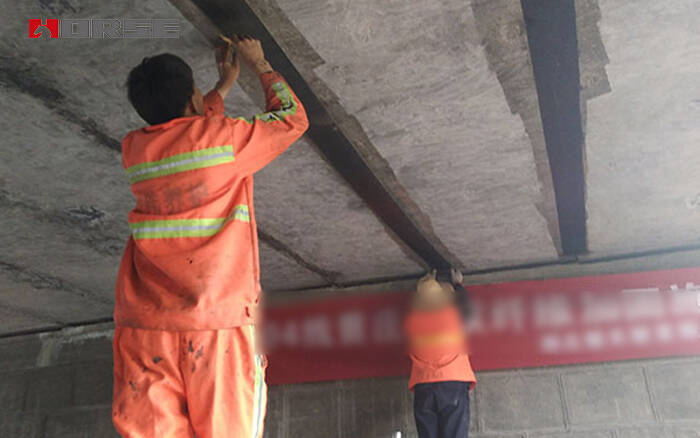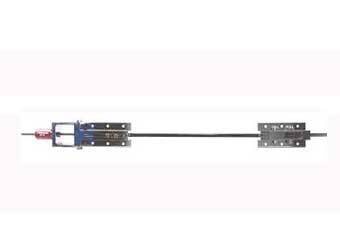Solutions
Horse Construction offers full range of structural strengthening materials with technical supports, documentation supports, products supports, project supports.
Application of Carbon Fiber Reinforcement Technology on Bridge Structure

Since the mid-1970s, some European countries have begun to apply fiber-reinforced composite materials (FRP) in the construction of civil engineering projects, and have exerted a relatively ideal effect in the actual application process. This kind of material exhibits strong rigidity and toughness, especially breaking through the traditional technology in terms of corrosion resistance. Applying it to the structural construction of concrete bridges significantly improves the overall stability of the bridge structure, and its advantages are also reflected in the shortening of the construction period and the reduction of labor costs. After half a century of development and improvement, this technology has also become one of the important directions of bridge construction in my country in the 21st century.
1. Carbon fiber sheet reinforcement construction technology
In a concrete bridge project in Jiangxi, the total length of the bridge is 115m, both ends are 18m high, and the highest point in the middle is 25m. The method of pasting carbon fiber sheets is used to strengthen the bridge structure, which has achieved a relatively ideal effect.
(1) Surface treatment technology
When applying carbon fiber sheet reinforcement construction technology, surface treatment technology is one of the most important technical means. Because there is a degraded layer composed of free lime, weathered layer or stripped mortar on the surface of the concrete structure, a grinder can be used to remove it. At the same time, it must be applied to the grinder and air nozzles. In this way, the concrete surface can be fully dried after being cleaned, which also makes the overall effect of surface treatment more ideal.
(2) Section repair technology
In the construction of concrete structure bridges, cross-section repair technology is often applied. When applying this technology, one should have a full understanding of the concrete surface structure. Under normal circumstances, the undesirable components of the concrete surface layer mainly include honeycombs, pores, and corrosion residues. It is precisely because of the existence of these undesirable structures that the bridge structure often has the phenomenon of steel reinforcement leakage. So pay attention to anti-corrosion treatment. It needs to be applied to epoxy mortar material, because this material is slightly larger than concrete material in strength and density, so its section repair effect is relatively ideal.
(3) Bottom coating
During the construction of the bridge structure, attention should be paid to the temperature control. Normally, the operating temperature should be kept below 5°C so that the construction work can be carried out normally. In the event of rainy weather, the construction should be temporarily stopped. For the scope of construction regulations, the normal temperature should be confirmed, and relevant construction technicians are required to make a reasonable selection of the underlying coating of the bridge structure, and in this way, the anti-corrosion effect of the bridge can be improved. It should be ensured that the construction site is always in a state of air circulation, and fireworks are strictly prohibited. In the process of bridge construction, relevant construction technicians should pay attention to wearing relevant protective equipment, such as safety helmets, rubber gloves, masks, and so on.
(4) Pasting of carbon fiber sheet
Carbon fiber sheet bonding is the most important link in the construction technology of carbon fiber sheet reinforcement. In this process, scissors should be used to cut according to the pre-designed size to ensure the overall fit of the current patch. In the process of cutting operations, attention should be paid to reasonable control of the cut size and length. Generally, it is considered to be controlled within 2m, so that the final carbon fiber sheet fit can be guaranteed. In order to effectively prevent the carbon fiber sheet from being damaged during storage, it is necessary to accurately control the number of cuts to ensure that it meets the actual demand and avoid a large amount of surplus. When the primer of the concrete bridge deck has been applied for more than one week, it should be smoothed with a grinder to ensure the overall smoothness of the bridge deck. It is necessary to apply a brush roller to uniformly coat the epoxy resin on the primer of the bridge structure. In this way, the roughness of the construction bridge deck can be effectively controlled. In the process of coating operation, you should pay attention to coating thicker corners. Leave a space of about 10 cm in the longitudinal direction of the fiber. After the fiber sheet pasting operation is completed, it should be placed for 30 minutes. If the fiber bursts during this process, the pulley should be used to deal with it in time.

2. Research on the application prospects of carbon fiber sheets to strengthen bridges
For the reinforcement technology of pasting carbon fiber sheets, it is still a new type of technology. Its scope of application is still being further expanded. At the same time, the carbon fiber sheet bonding reinforcement method has also become an ideal rapid bridge reinforcement method, which is especially suitable for application in the construction of highway bridges, which can effectively improve the overall stability of the bridge structure. For carbon fiber materials, due to their advantages of light weight and simple construction operation, heavy equipment is often not needed to assist them during on-site bonding construction, and its application prospects in my country are very broad. The research on carbon fiber bridge reinforcement technology in some western developed countries far exceeds that of our country. Therefore, when our country is exploring and developing in this area, we can actively use the research experience of Western countries to combine it with the actual situation of my country's highway bridges at this stage. Systematic guidelines for carbon fiber sheet reinforcement technology should be established as soon as possible within the industry in our country. And pay attention to the continuous innovation of the new technology of sticking carbon fiber sheets to the concrete highway bridge structure to achieve reinforcement, so as to promote the continuous improvement of the level of my country's original highway bridge reinforcement and maintenance work.
3 Concluding remarks
In summary, after long-term practical operations, the application of carbon fiber reinforced composite materials in the construction of road and bridge structures has exerted a relatively ideal effect. Its advantages are also very obvious, not only the on-site construction operation is more convenient, compared with the traditional reinforcement construction plan, its cost control effect is also very ideal. At the same time, the application cycle of carbon fiber bridge reinforcement technology is relatively short, which also significantly reduces its impact on the transportation system and the surrounding environment. At present, the application scope of single-fiber reinforcement technology in bridge engineering in my country is constantly expanding, and its market application prospects are also very broad, and it can be applied in various types of road and bridge engineering. It provides a wealth of reference experience for my country's road and bridge construction, and also promotes the healthy and stable development of the road and bridge construction industry.
You can find anything here you are in need of, have a trust trying on these products, you will find the big difference after that.

High strength, unidirectional carbon fiber wrap pre-saturated to form a carbon fiber reinforced polymer (CFRP) wrap used to strengthen structural concrete elements.

High strength carbon fiber reinforced polymer (CFRP) strip / laminate / plate for structural strengthening and concrete repair

Prestressed carbon fiber reinforced polymer(CFRP) strip for slab, beam strengthening to increase stiffness, reduce distortion and deflection of members, reduce the cracks, avoid and stop cracking.